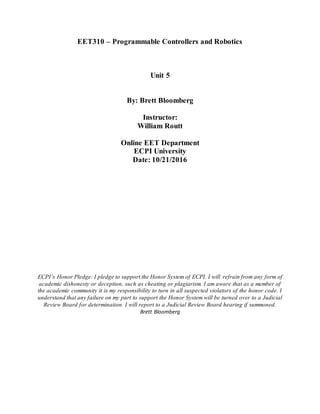
PLC unit 5 lab Brett Bloomberg-1
- 1. EET310 – Programmable Controllers and Robotics Unit 5 By: Brett Bloomberg Instructor: William Routt Online EET Department ECPI University Date: 10/21/2016 ECPI’s Honor Pledge: I pledge to support the Honor System of ECPI. I will refrain from any form of academic dishonesty or deception, such as cheating or plagiarism. I am aware that as a member of the academic community it is my responsibility to turn in all suspected violators of the honor code. I understand that any failure on my part to support the Honor System will be turned over to a Judicial Review Board for determination. I will report to a Judicial Review Board hearing if summoned. Brett Bloomberg
- 2. Objective: These final labsthatwe are to performhave broughtthe more advancedconceptstolightand made us betterengineers.We have learnedthatwe canmake PLC’sperformcircuitry,andBooleanoperations withease.Ourprogramingskillswiththislabhave increasedfromthe knowledgewe learnedfromthe lecturesandbooks.We learnedhowshiftregisters, NetworkingPLC’s,andone of the mostimportant trouble shooting.These labshelpeduslearnwhattolookfor whensomethingwasn’tworkingquite right. Lab 12-9 Thislab asksus to implementthe shiftregisterspray paintingapplicationprogramshownbelow.The sequence of operationisasfollows. Each file bitlocationrepresentsastationonthe line,andthe statusof the bitindicateswhetherornota part is presentatthe station. The bit addressI:1/2 detects whetherornota part has come onthe line. The shiftregistersfunctionisusedtokeeptrackof itemsto be sprayed.A bitshiftleftinstructionisused to indicate aforwardmotionof the line.Asthe partspassalong the productionline,the shiftregisterbit patternsrepresentthe itemsonthe conveyorhangertobe painted.LS1is usedtodetectthe hangerand LS2 to detectthe part. Whena part tobe paintedanda part hangeroccur in sequence (indicatedbyasequential closingof LS2 followbyLS1 logic1 is inputintothe shiftregister. The logic1 will cause the undercoatspraygun to operate,andfive stepslater,when1occurs in the shift register,the topcoatspraygun isoperated.Limitswitch3counts the parts as theyexitthe oven. The counts obtainedbylimitswitch2and limitswitch3shouldbe equal atthe endof the spraypainting run. PL1 isenergizedandisan indicationthatthe partscommencingthe spraypaintingrunequal the parts that have completedit.Logic0 inthe shiftregisterindicatesthatthe conveyorhasnoparts onit to be sprayedand inhibitsthe operationof the spray. Operations: Thisprogram worksininterestingways,butitisa basicshiftregister.Once youknow the basicsof how theywork,and whatit takes to setthe bitto a zeroor a 1. The requirementsthatthe labasksyouis in orderto set a 1 inthe 8 bitregisteryoufirstneedlimitswitch2to be set,and thensetlimitswitch1. The settingof limitswitchone locksthe bitintothe register.When yousetlimitswitch3it meansthat once limitswitch1 doesgetsetthat it will lockina zerointothe bit register. The shiftregisterisstored inthe internal bitof B3:0. Thiswill letyousee the whole registerandhow the bitsare shiftingthrough. WhenbothB3:0 andb3:5 are made each one will displayalightindication.
- 3. Conclusion: As youcan see if bothlimitsswitchone andlimitswitchthree are equal itwill lightupa lightthatwill showwhenboththe inputand the outputof the systemare equal.Thisprogramisfairlysimple indesign and implicational use of the shiftregister.Settinga1 or a 0 inthe registerisn’thard.TO geta one limit switch2 needsto be activated,andto seta 0 limitswitchthree needstobe activatedwhile limitswitch 1 isactivated.
- 4. Lab 12-10 Thislab asksus to implementthe shiftregister programusedtokeeptrackof carriersflowingthrough the 16 stationsprogram shownbelow. The program is as follows Proximity switches #1sense acarrier, while proximityswitch#2sensesapart of the carrier. Pilotlightsconnectedtooutputmodule O:4turnonas carrieswithpartsmove throughthe machine. Theyturn off as emptycarriesmove through. Station#4 isan inspectionstation.If the partfails,the inspectorspushPB1astheyremove the part from the system.WhichturnsoutputO:4/4 Off. Reworkisaddedback intothe systemat station#6. Whenthe operatorputs a part on an emptycarrier he or she pushespb2turningoutputO:4/6 on. The program is blow. Thisis a simple program,butithas a huge function.Inorderto make thisprogram shiftthe bitsthrough the registerwe have tolatch or unlatchto move the bitdownthe O: 4
- 6. Conclusion: Thisshiftregisterallowsthe outputstobe usedasthe register.We usedO:4 to monitorthe bitsthat wentthroughthe register.Eachtime it wouldcounttokeeptrack of the parts onthe system.The lights will turnoff whenthe spotisemptyinthe physical worldshowingthatthe physical andlogical actually match up. Lab 12-11 Thislab asksus to implementthe firstinfirstoutinstructionsetof the shiftregisters.Boththe Fifo instructionsare outputinstructions,andtheyare usedasa pair.The fifolaodFFLloadsdata from a source elementandthe FIFOunloadunloadsthe instructiondatafroma file toa destinationword.This program permitsthe stackingof datain a file.Twoseparate shiftspulsesare required:one toshiftdata intothe file (load) andthe otherone isshiftdataout of the file (unload). Thisis a simple firstinfirstoutdata shiftregister,anditworksverywell.We see withthe program below. Asyoucan see fromthe integertable thatI have addednumbersintothe table todemonstrate howthisprogram workseach numberthatisentereddoesn’tmatterasmuchas what the program does withit.
- 9. What thisprogram doesistakesthe random numbersandsetsthemall to zeros,once thatis done itwill setthemall to 5’s or the firstnumberthatis inthe shiftregister.Whendealingwithregistersof this nature it isimportantto rememberthatitisfirstinfirstout. Thismeansthat if the firstnumberinis a 5 the last numberwill travel all the waydownthe registeruntil itisunloaded.Thiswill setthe entire registeras5’s since it traveleddownthe line as5’s.Youcan resetthisbyunloadingall of the numbers and loadingina zero.Thiswill loadinzerosuntil itiscompleted. 13-3 Trouble shooting Thislab asksus to lookat the PLC program and execute tosequentiallyturnPL1 off for5 secondsandon for 10 secondswheneverinputaisclosed.Troubleshootthe circuitandidentifywhatneedstobe changedto have itoperate properly.Use the I/osimulatorscreenandthe following.The firstpicture belowisthe startingprogram.Thisprogram has errorsin itthat don’treallyallow the programto operate properly,asthe applicationisdesiredtooperate. We see thatthe systemdoesn’tturnproperly. I noticedthatthe needforinternal bitwasunneeded.The firstprogramisthe books,andthe secondis my changedprogram.
- 10. I addedthe timerlatchto the firstrung,whichmakesthe pushbuttonandusernotworry abouthaving to holddownthe pushbuttonto keepthe programgoinglatchinginthe timerintoit allowsthe userto justhave to pushthe buttoninorderto start the program.My secondchange was to remove the internal bitusedtostopthe timersandthe latchedinfirstcounter.I removedthatbecause itwas redundantanddidn’tneedtobe inthe program.Once the secondtimerisdone counteritturnsoff the firsttimerandturns off the system.Whenthe secondtimeriscounteritturns onPL1.
- 11. Havingto thinkaboutwaysto make a programwork fromsomeone else’sprogramcertainlymakes thingsinteresting.Havingtounderstandtheirlogicof whytheyprogramedthe things thatthey programed,andfindingoutwhatisnecessaryandwhat isnot. Beingable tounderstandtheirlogiccan be difficult.Ithinkthere isn’tarightandwrong wayto program. There are easierways,butthere isno rightanswerinorder to make somethingworkornot.You can have a programwith10 rungs dothe same thingwitha program with2. It all dependsonhow youthinkof the program and the applicationat hand.Trouble shootingaPLC isdifferentthananythingelse inthe worldof automation.It’sthe code or the brainof howthe systemworks.It’snotsomethingthatcomeseasytoeveryone,butwhenyouhave that knowledgeandabilitytosee howthe code shouldflow verseswhatitsactuallydoingisaskill thatis highlyvaluable. Lab 13-4 Thislab asksus to construct a simulatedPLCprogramforthe program editingandcontrol.The program isgivenandwe have tofollowinstructionsonwhatto doin orderto make the program workproperly. The PLC program and requirementsare listedbelow.
- 12. Once we made all the changesthe program lookedlikethis.
- 13. As youcan see I may nothave followedthe directionscompletely.The directionswerealittle hardto understandintermsof whatthe start and runrung were andwhichrung was whichsince myprogram startedwithrung 0 and the drawingstartedwithrung1. Thisyoumay thinkisa simple mathproblem, but whenyouare deletingmultiple rungsandinsertingthemaswell youlosewhichrungwassupposed to be remove andwhichone wasn’t.Thisbringsup a whole listof communicationerrorsthatcan happenwhentryingtocommunicate tothe program whatthe program needstodo, andwhat words and the tone of howto make the corrections. Conclusions: Since wrappingupthisPLC laband the mainPLC course I have foundor renewedmyenjoymentfor automationandplc programming.Iam veryinterestedinlearningmore aboutroboticsandhow to program themas well.Iwishwe gotmore intoroboticsand their applications,butthiswasa veryfun course.I didactuallylearna lotand had a verygoodrefresher.We learnedaboutshiftregistersand othertopicsthat we didn’tlearnaboutinthe main course whichIthoughtwas veryinteresting. I enjoyedthiscourse andIam excitedthatmytime here iscomingto an end.I am hopingthatwithall my experience Iwill findmyeducationagoodreturnon investment,andbe fulfilled.Thiswill be ajourney. References: Petruzella,F.(2011) LogixproPLC labmamual foruse withprogrammable logiccontrollers( fourthed). NewYork,NY: McGraw-Hill Petruzella,F.D.(2011). LogixPro PLClab manualforusewith programmablelogiccontrollers. NewYork, NY: McGraw-Hill. LogixPro(VersionTLP) [Computersoftware].(n.d.).